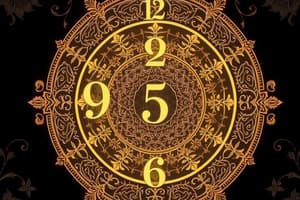Podcast
Questions and Answers
What is a fundamental property of whole numbers when added or multiplied?
What is a fundamental property of whole numbers when added or multiplied?
- The result is always a whole number (correct)
- The order of whole numbers always changes the result
- The result can be a fraction
- The result can be a decimal
Which of the following fractions can be simplified by dividing both numerator and denominator by their greatest common divisor?
Which of the following fractions can be simplified by dividing both numerator and denominator by their greatest common divisor?
- Only proper fractions
- Only mixed fractions
- Only improper fractions
- All types of fractions (correct)
What is the result of adding or multiplying two whole numbers according to the commutative property?
What is the result of adding or multiplying two whole numbers according to the commutative property?
- The result changes depending on the order
- The result does not change depending on the order (correct)
- The result is always a decimal
- The result is always a fraction
Which type of fraction has a numerator that is greater than or equal to the denominator?
Which type of fraction has a numerator that is greater than or equal to the denominator?
What is the result of converting a fraction to a decimal?
What is the result of converting a fraction to a decimal?
What is the purpose of the denominator in a fraction?
What is the purpose of the denominator in a fraction?
What is the result of dividing both the numerator and denominator of a fraction by their greatest common divisor?
What is the result of dividing both the numerator and denominator of a fraction by their greatest common divisor?
What is the set of numbers that includes all positive and negative whole numbers, as well as zero?
What is the set of numbers that includes all positive and negative whole numbers, as well as zero?
What is a decimal that has a finite number of digits?
What is a decimal that has a finite number of digits?
What operation is not allowed for whole numbers?
What operation is not allowed for whole numbers?
What is the equivalent of 1/2 when converted to a decimal?
What is the equivalent of 1/2 when converted to a decimal?
What is the purpose of the numerator in a fraction?
What is the purpose of the numerator in a fraction?
What is the set of numbers that includes all positive integers, including zero?
What is the set of numbers that includes all positive integers, including zero?
What is the result of converting a decimal to a fraction?
What is the result of converting a decimal to a fraction?
Flashcards are hidden until you start studying
Study Notes
Number System
Integers
- A set of whole numbers and their negatives (including zero)
- Can be positive, negative, or zero
- Examples: ..., -3, -2, -1, 0, 1, 2, 3, ...
- Can be represented on the number line
- Properties:
- Closure: The result of adding or multiplying two integers is always an integer
- Commutative property: The order of integers does not change the result of addition or multiplication
- Associative property: The order in which integers are added or multiplied does not change the result
Decimals
- A way to represent fractions using a base-10 number system
- Consist of a whole number part and a fractional part separated by a decimal point
- Examples: 0.5, 3.14, 2.78
- Can be converted to fractions
- Can be used to represent repeating or non-repeating decimals
Whole Numbers
- A set of non-negative integers (including zero)
- Examples: 0, 1, 2, 3, 4, 5, ...
- Properties:
- Closure: The result of adding or multiplying two whole numbers is always a whole number
- Commutative property: The order of whole numbers does not change the result of addition or multiplication
- Associative property: The order in which whole numbers are added or multiplied does not change the result
Fractions
- A way to represent part of a whole
- Consist of a numerator (top number) and a denominator (bottom number)
- Examples: 1/2, 3/4, 2/3
- Can be simplified by dividing both numerator and denominator by their greatest common divisor
- Can be converted to decimals
- Types:
- Proper fractions: Numerator is less than the denominator
- Improper fractions: Numerator is greater than or equal to the denominator
- Mixed fractions: A combination of a whole number and a proper fraction
Number System
- Integers are a set of whole numbers and their negatives, including zero.
- Integers can be positive, negative, or zero.
- Examples of integers include ..., -3, -2, -1, 0, 1, 2, 3, ...
- Integers can be represented on the number line.
Properties of Integers
- Closure: The result of adding or multiplying two integers is always an integer.
- Commutative property: The order of integers does not change the result of addition or multiplication.
- Associative property: The order in which integers are added or multiplied does not change the result.
Decimals
- Decimals are a way to represent fractions using a base-10 number system.
- Decimals consist of a whole number part and a fractional part separated by a decimal point.
- Examples of decimals include 0.5, 3.14, 2.78.
- Decimals can be converted to fractions.
- Decimals can be used to represent repeating or non-repeating decimals.
Whole Numbers
- Whole numbers are a set of non-negative integers, including zero.
- Examples of whole numbers include 0, 1, 2, 3, 4, 5, ...
Properties of Whole Numbers
- Closure: The result of adding or multiplying two whole numbers is always a whole number.
- Commutative property: The order of whole numbers does not change the result of addition or multiplication.
- Associative property: The order in which whole numbers are added or multiplied does not change the result.
Fractions
- Fractions are a way to represent part of a whole.
- Fractions consist of a numerator (top number) and a denominator (bottom number).
- Examples of fractions include 1/2, 3/4, 2/3.
- Fractions can be simplified by dividing both numerator and denominator by their greatest common divisor.
- Fractions can be converted to decimals.
Types of Fractions
- Proper fractions: Numerator is less than the denominator.
- Improper fractions: Numerator is greater than or equal to the denominator.
- Mixed fractions: A combination of a whole number and a proper fraction.
Number System
- A fraction represents part of a whole and consists of a numerator (top number) and a denominator (bottom number).
- The numerator tells how many equal parts are being referred to, and the denominator tells how many parts the whole is divided into.
- Examples of fractions include 1/2, 3/4, and 2/3.
- Fractions can be simplified by dividing both the numerator and denominator by their greatest common divisor (GCD).
Whole Numbers
- A whole number is a positive integer, including 0.
- Examples of whole numbers include 0, 1, 2, 3, and so on.
- Whole numbers can be added, subtracted, multiplied, and divided (except by 0).
- Whole numbers can be represented on a number line.
Decimals
- A decimal is a way to represent a fraction with a denominator that is a power of 10.
- Examples of decimals include 0.5, 3.14, and 2.78.
- Decimals can be added, subtracted, multiplied, and divided (except by 0).
- Decimals can be converted to fractions by dividing by a power of 10.
Integers
- An integer is a whole number, either positive, negative, or zero.
- Examples of integers include ..., -3, -2, -1, 0, 1, 2, 3, and so on.
- Integers can be added, subtracted, multiplied, and divided (except by 0).
- Integers can be represented on a number line.
Percentages
- A percentage is a way to represent a fraction with a denominator of 100.
- Examples of percentages include 25%, 50%, and 75%.
- Percentages can be converted to decimals by dividing by 100.
- Percentages can be used to represent proportions, ratios, and increases/decreases.
- Examples of percentage calculations include:
- Increase: 25% of 100 = 25
- Decrease: 25% of 100 = -25 (subtracted from 100)
- Proportion: 25% of 80 = 20
Studying That Suits You
Use AI to generate personalized quizzes and flashcards to suit your learning preferences.




